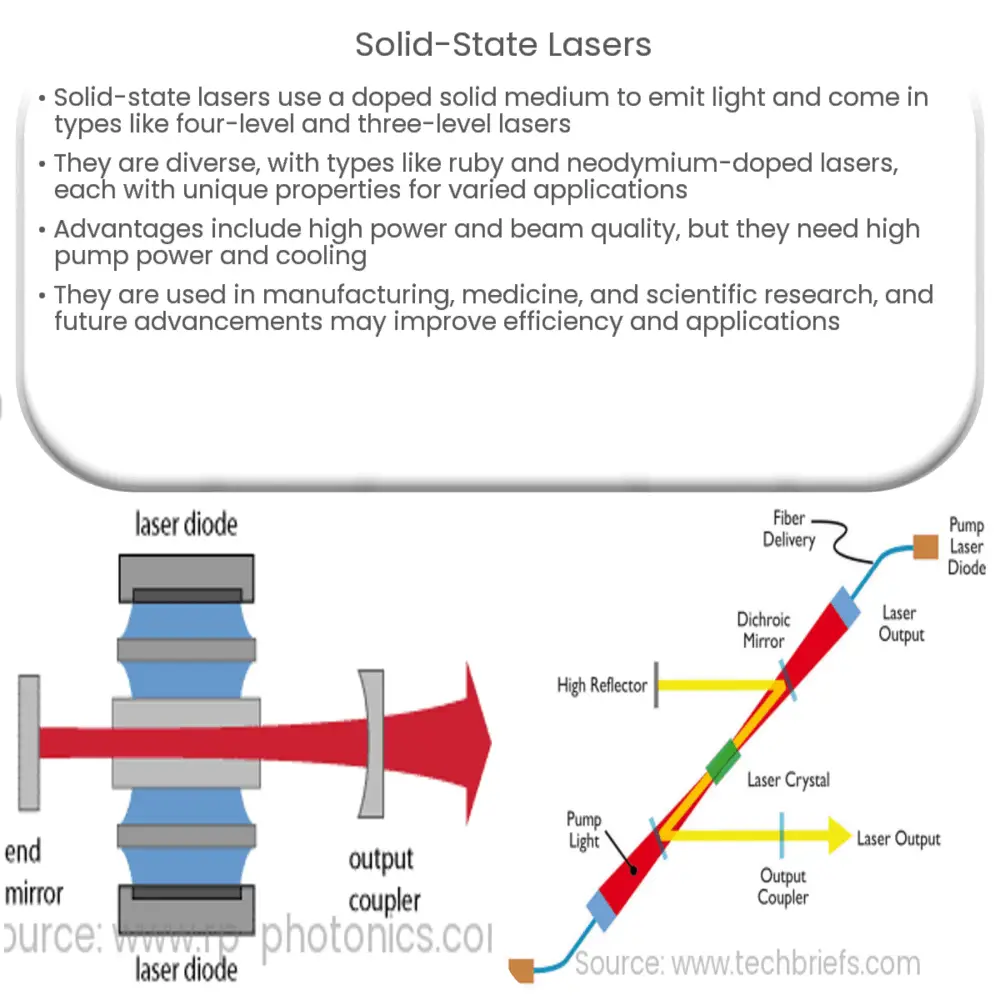Explore the principles, types, applications, and future prospects of solid-state lasers in our comprehensive guide. Delve into this powerful technology’s impact across industries.

Solid-State Lasers: An Introduction
Solid-state lasers, a key type of laser technology, have experienced significant advancements since their inception. They have found diverse applications in various fields, from manufacturing and medicine to scientific research.
Principles of Solid-State Lasers
Solid-state lasers use a solid medium, typically a crystal or glass, which is ‘doped’ with ions that provide the necessary energy states. When the doped medium is excited by an energy source, it emits light, leading to laser operation. The most common type of solid-state laser is the 4 level laser, but others exist as well.
- Four-Level Lasers: These lasers employ four different energy levels in their operation. The ions in the medium are excited to a higher energy level, then they quickly drop to a lower level, where they stay for some time (the metastable state). From this level, the ions can be stimulated to emit radiation and drop to an even lower energy level before returning to the ground state.
- Three-Level Lasers: Unlike four-level lasers, three-level lasers operate with only three energy levels. This often requires more energy to achieve population inversion, making these lasers less efficient.
Types of Solid-State Lasers
There is a diverse array of solid-state lasers, each with unique properties that lend themselves to different applications.
- Ruby Lasers: The first successful laser ever made, the ruby laser, is a solid-state laser. Its lasing medium is a ruby crystal, and it emits a red light at 694.3 nm.
- Neodymium-Doped Lasers: This is another commonly used solid-state laser type. They use a crystal (often YAG, Yttrium Aluminum Garnet) doped with neodymium ions. Neodymium-doped lasers are particularly versatile and find use in diverse applications, from industrial cutting and welding to medical surgery.
Advantages and Limitations
Advantages of solid-state lasers include high output power, high beam quality, and a broad range of emission wavelengths. Despite these strengths, solid-state lasers also have limitations, such as the need for high pump power and cooling, as well as potential issues with optical damage due to their high peak powers.
Applications of Solid-State Lasers
Solid-state lasers are widely employed across various industries and fields of study.
- Material Processing: In manufacturing and industry, solid-state lasers are used for processes such as cutting, welding, and drilling materials. Their high power and beam quality allow precise control and efficient processing.
- Medicine: In medical applications, solid-state lasers are used for a range of procedures including eye surgery, dermatology, and in various surgical procedures due to their precision and control.
- Scientific Research: Solid-state lasers play a crucial role in several areas of scientific research, including spectroscopy, quantum physics, and in the development of new technologies like quantum computers.
Future of Solid-State Lasers
As technology continues to evolve, the future of solid-state lasers looks promising. Advancements in material science are expected to yield new lasing mediums with improved efficiencies and properties. Additionally, emerging applications in areas such as telecommunications, renewable energy, and quantum computing could further drive the development of solid-state lasers.
Conclusion
In conclusion, solid-state lasers are a versatile and powerful technology that has significantly impacted many aspects of our lives. From manufacturing and medicine to scientific research, these lasers have proven to be invaluable tools. While they do have their limitations, ongoing advancements in materials and technology promise to push the boundaries of what is possible with solid-state lasers. As we look to the future, it is clear that solid-state lasers will continue to play a crucial role in numerous applications and in the advancement of technology.

